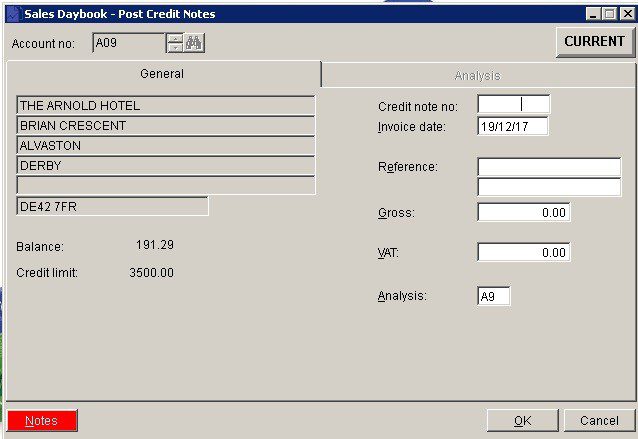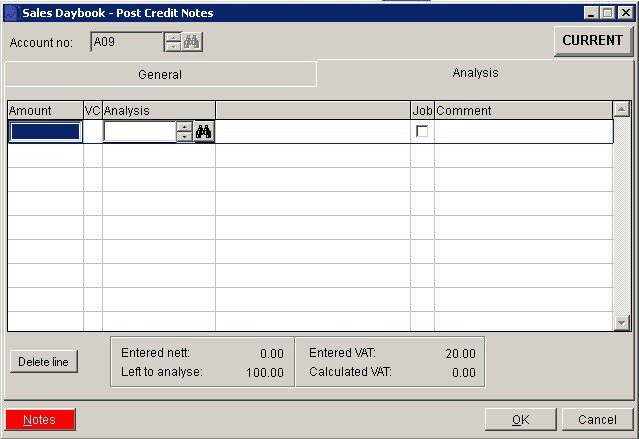Sales Ledger – Post Credit Notes
Purpose:
Use to post credit notes that have been produced outside the system, for example hand-written credit notes or produced by other software.
Preparation:
The following list of possible preparation steps will help you decide if you need to do anything before processing and if you need help.
Select a company – see Change Companies.
Obtain an up-to-date customer list – see List Customers.
Obtain an up-to-date nominal code list – see List Chart of Accounts.
Ensure customer details are up to date – see Create & Edit Customer Accounts.
Ensure you have details of Delivery Addresses for goods despatched.
Set the default transaction date as required – see Change Default Transaction Date.
Processing:
On the main menu click Daybooks > Sales Daybook > Post Credit Notes, or;
On the main menu click View > Configure Toolbar > Open Form – see Configure Toolbar Form.
Check the box to the left of Post Credit Notes Invoices.
Click Apply button to display the control button –
Click the control button to open form see Sales Daybook Post Credit Notes form below.
Either: Select required customer, or; type in a new account number then click Yes on the message box to create a new account – see Add Customer Account Form – remember to enter the customer’s full details as soon as possible – see Create & Edit Customer Accounts.
Post the credit note nett of VAT amount to individual Nominal Ledger Codes line by line using the mouse or tab keys to navigate along lines and Return to accept the entries and move to the next line.
Click OK to accept and update records or click Close.
Alternatively, many invoices and credit notes may be posted at once – use Daybooks > Sales Daybook > Batch Postings – see Post Sales Transactions Form or may be imported if they have been produced on other software – see Import Sales Transactions.
Balancing/Reconciliation:
Export or print Daybook Listing and ensure all invoices/credit notes have been posted – see Print Sales Daybook Listings.
Filing:
If posting from hard copies write the entered/system generated document number onto the Invoice. File in document number order.
If posting from spreadsheet annotate reference in column on the same row.
File copy of Daybook listing with documents – electronically, in a backed up directory if possible.

- Date: Either: Manual entry formatted as DD/MM/YY. Type over the parts of the date you wish to change – the system will skip over the “/” part itself. If the date you enter is invalid; the cursor will return to the start of the date and await a valid entry, or; click on the field to highlight data – white on a blue background – then Right Click to open the Calendar Menu – see Dates and Calendar.
- References: 2 fields of 16 Characters.
- Gross: Total amount shown on invoice including VAT.
- VAT: VAT amount shown on invoice.
- Analysis: Maximum 2 characters account specific – customers can be grouped together for reporting. Defaults to code shown on ledger account – see Report Sales Activity.
- Click ‘OK’ To save and close or ‘Cancel‘ to close without saving.

- Amount: Nett amount for the analysis code to be entered.
- VC: VAT code relating to the nett amount entered.
- Analysis: Nominal analysis relative to amount + cost centre where appropriate.
- Comment: Text to appear in Nominal Ledger against the entry.
- Entered nett will accumulate amounts entered and Left to Analyse will reduce the amounts from calculated net amount and should end up at NIL. The Entered VAT (from General Page) must match the Calculated VAT from the entries above. Where they do not match you can go back and adjust.
- Click ‘OK’ to save and close or ‘Cancel’ to close without saving.

0 Comments